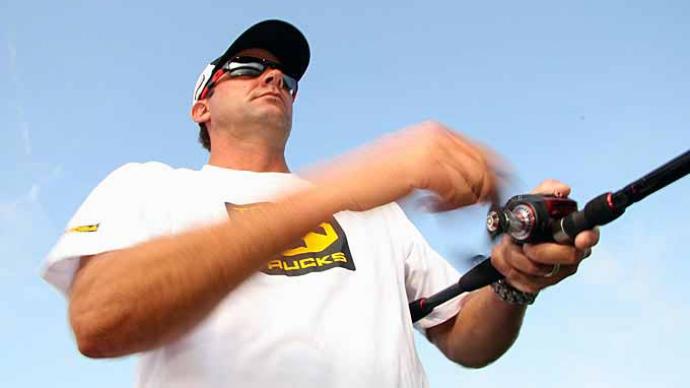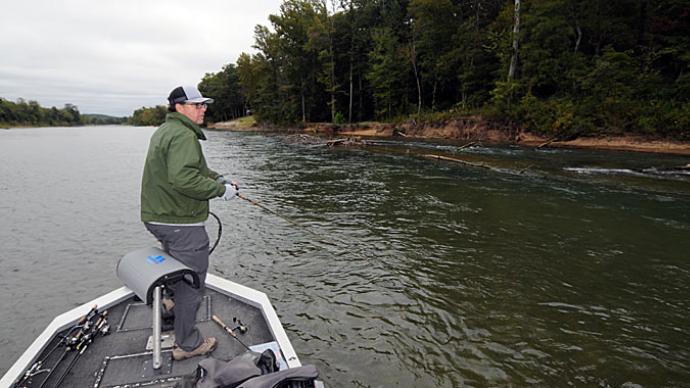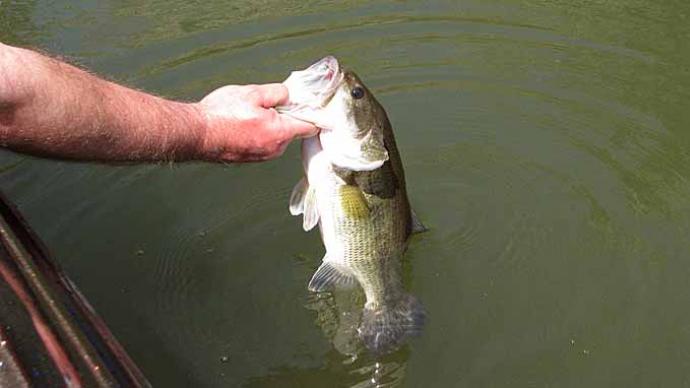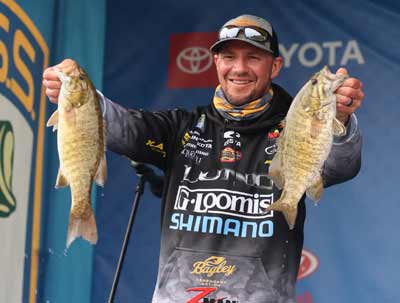
Fall is a wonderful time of year. The days are cool and the air dry, a welcome relief from hot and sticky summer. Fewer pleasure boaters on the water mean more peace, quiet, and room for anglers to enjoy. But even with all that good, there is some dread. You almost can feel time ticking away and winter nearing.
Bass — largemouth, smallmouth, and spotted — enjoy autumn, too. Changing weather, less daylight, and other environmental changes put them on the feed and move, often into shallow water for a spell before retreating to deep water.
Keeping up with fall bass can be a challenge. They seem to move by the day, sometimes the hour. Bassmaster Elite Series angler Jeff Gustafson has an idea of what causes that. “I don’t believe water temperature influences [fall] movements at all,” he said. “It’s all about the length of day shortening up that causes fish to start moving toward wintering locations.”
Measuring daylight isn’t easy. But it is simple to take the water temperature, considering nearly every boat used for bass fishing has at least one graph that provides a continuous water temperature reading. And while a temperature doesn’t necessarily push bass to do a particular thing, it can coincide with when bass hold on to certain types of spots and prefer specific lures. Simply looking at the water temperature will point your fishing efforts in the right direction.
Water in the 70s
When the unofficial end of summer — Labor Day — rolls around, weather and water conditions often still feel like summer. The sun shines bright, and the water temperature hasn’t cooled by much or at all. But then things start happening.
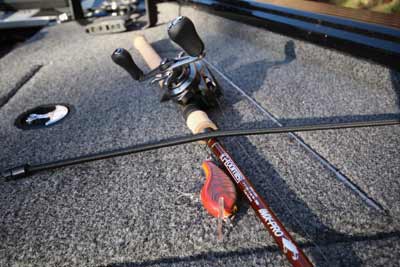
Gustafson said the first few cold nights push bass from shallow cover, such as aquatic vegetation, a favorite haunt for bass in the Northern natural lakes and rivers around his western Ontario, Canada, home. “But really, it’s the length of day that starts to drive the movements because we’ll find fish shallow and deep from this point right through the late fall,” he said. “The biggest change is that fish will move from where they spent much of their time in July.”
Bass have two things to accomplish in the fall. They need to feed up for winter, and they need to swim to their wintering hole. Gustafson said they aren’t equal. “I feel like food drives the motivation for smallmouth activity levels, which are usually high throughout the fall until we freeze up,” he said.
At the start of fall, bass are on the hunt. Even though conditions have not changed much, they start to feel the push to feed up for winter. So, find their food, and you’ll find them.
Bass are active when the water temperature is in the 70s. Topwaters, spinnerbaits, swim jigs, and crankbaits draw strikes, even when retrieved at a healthy clip. Aim your casts around cover along migration routes such as long points and creek channels. You won’t need to follow them to the back of coves or creeks. Focus on shallow water that’s near deep water instead. It could be the top of a point or along a main-lake shoreline.
Water in the 60s
Gustafson said bass don’t slow much when the water temperature falls into this range. It still is warm enough to get cold-blooded bass moving, so they continue to feed fast and furious. He said horizontal presentations — vibrating jigs, spinnerbaits, crankbaits — remain effective.
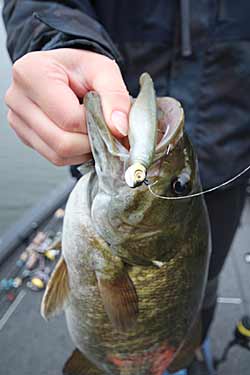
Gustafson isn’t in a rush to put away his topwater lures. “I’ll keep [them] in the lineup into the 50s, as long as there is still bait showing up high in the water column, or I’m still seeing the odd busting going on.” He often reaches for a walking bait such as Bagley’s Knocker B 11.
Gustafson searches for largemouth in any remaining stand of lush green aquatic vegetation that he can find. “And if there is rock mixed in, it’s a good spot,” he said. It’s a similar search for smallmouth. He said smallmouth return to shallow water on some bodies of water, such as Lake St. Clair, which Michigan and Ontario share. But on most waters, he said they will move toward structure in the central basin, especially as the water temperature nears the 60-degree mark.
Water in the 50s
Gustafson said fall fishing is at its peak when the water temperature is in the 50s. The urge to feed is at its strongest. “The fish know that things are changing, and they want to fill their bellies [before winter],” he said.
Keeping up with bass at this point still requires a moving bait. Crankbaits perfectly fit the bill because they can be towed at various speeds. Gustafson switches between wide-bodied crankbaits, which have wide aggressive wobbles, and ones with slim profiles such as Bagley’s Flat Balsa B. “It’s a great fish catcher in cold water and does a good job sliding through sparse grass,” he said. “But don’t overlook a Chatterbait fished slower during this period as well.”
Gustafson isn’t casting these lures everywhere. Smallmouth are usually found in deep water, and largemouth use the deepest aquatic vegetation that’s still green. “During this timeframe, it’s all about finding the sweet spots,” he said. “Both species start to group up, so there is more room for a hero or zero-day.” Pinpointing these spots requires a greater reliance on his electronics.
Water in the 40s and colder
See these temperatures on your electronics, and it’s almost certain bass have found their wintering hole, where they’ll park themselves until the process reverses — more daylight and warming temperatures drawing them to shallow water again. But don’t hang up your gear or park your boat until spring. “The fishing is still good if you find them,” Gustafson said.
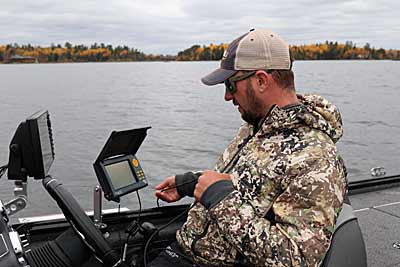
Smallmouth are structure-oriented at this point in the season. Gustafson said it could be a point, hump, or flat strewn with a few boulders. “In the coldest water late in the season, we’re finding tight groups of fish,” he said. “And they will probably be deeper than they are all year.”
Gustafson will see these bass on his electronics. But he’ll want a better view. So, he uses an Aqua-Vu underwater camera. Not only does its live feed confirm that the fish are bass, but it also reveals the not-so-obvious spot on a spot, such as a boulder embedded in the bottom that will hold a small pack of bass.
Bass are oriented to the bottom when the water is in the low 40s, so that’s where Gustafson sends his lure. “I’m going with a Damiki style rig this time of year,” he said. This simple setup consists of a shad-shaped jig head and a soft-plastic lure. It gained widespread bass-fishing attention in 2017 when it was used by several top finishers at a Bassmaster Elite Series stop on Tennessee’s Cherokee Lake.
Gustafson’s version of the Damiki rig starts with a 3/8-ounce Smeltinator jig, which a friend in Canada makes. He rigs it with a 4- or 5-inch shad bait such as a Z-Man Jerk ShadZ. It’s the lure he used to win the 2021 Bassmaster Elite Series tournament on the Tennessee River. He vertically fished it with a 7-foot, 3-inch medium-action G Loomis spinning rod, 3000-size Shimano Exsence reel, 10-pound PowerPro braided line, and an 8-pound test fluorocarbon leader. The key was placing his lure just above the bass and imparting almost no movement.
The four-day tournament took place at the end of February, and Gustafson believes the bass he targeted on rocks in about 20 feet of water had been there a while. “I think I found a wintering area, evident by comments I heard from local anglers after the event,” he said. “There were a bunch of fish congregated there. It was my lucky week!”
BassResource may receive a portion of revenues if you purchase using a link above.


